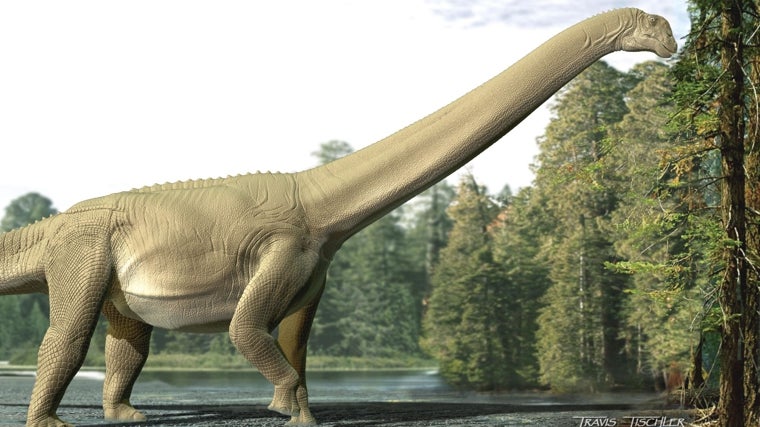A vegetarian feast that was swallowed without chewing was found inside the guts of a titanosaur.
-U02648403055oYZ-1024x512%40diario_abc.jpg&w=1280&q=100)
Researchers at Curtin University have found remains of "dinner" in the abdomen of a titanosaur that lived approximately 100 years ago in what is now Queensland, Australia. The vegetarian feast, composed of a variety of plants, supports the long-established hypothesis that these dinosaurs were herbivores. Furthermore, according to the study published Monday in the journal Current Biology, the remains show that the sauropod didn't chew and relied almost entirely on its gut microbes for digestion.
"Genuine sauropod gut contents have never been found before, despite the fact that they are known from fossils found on every continent and the group is known to span at least 130 million years," says lead author Stephen Poropat. "This finding confirms several hypotheses about the diet of these dinosaurs, based on studies of their anatomy and comparisons with living animals."
Knowledge of dinosaur diets is crucial to understanding their biology and the role they played in ancient ecosystems. However, very few dinosaur fossils have been found with preserved colloliths or gut contents. Sauropod colloliths have remained particularly elusive, even though these dinosaurs may have been the most ecologically impactful terrestrial herbivores globally during much of the Jurassic and Cretaceous periods, given their gigantic size.
 Artist's impression of Diamantinasaurus matildae feeding
Travis Tischler
Artist's impression of Diamantinasaurus matildae feeding
Travis Tischler
Due to this lack of direct evidence, the specifics of the plants they consumed have been largely inferred based on anatomical features such as tooth wear, jaw morphology, and neck length.
In the summer of 2017, Australian Museum of Natural History staff and volunteers excavated a relatively complete subadult skeleton of the mid-Cretaceous sauropod Diamantinasaurus matildae from the Winton Formation in Queensland. Nicknamed 'Matilda', the giant had a stocky appearance. At the shoulders, it would have stood 2.5 m tall, and based on comparisons with other related sauropods from around the world, it was probably 16 m long, with a long neck and tail. During the process, the researchers noticed an unusual layer of fractured rock that appeared to contain the sauropod's collolith, composed of numerous well-preserved plant fossils.
Analysis of plant specimens from the collolith showed that the sauropods likely only minimally processed their food orally, relying instead on fermentation and their gut microbiota for digestion. The collolith was composed of diverse plants, including conifer foliage (seed plants), seed fern fruiting bodies (plant structures that house seeds), and angiosperm leaves (flowering plants), indicating that Diamantinasaurus fed indiscriminately and in large quantities.
"The plants inside show evidence of having been cut, possibly bitten, but not chewed, supporting the hypothesis of mass feeding in sauropods," Poropat says.
The researchers also found chemical biomarkers from both angiosperms and gymnosperms, a group of seed-producing woody plants that includes conifers. “This implies that at least some sauropods were not selective feeders, but rather ate any plant they could safely reach and process,” Poropat says. “These findings largely corroborate previous ideas about the enormous influence sauropods must have had on ecosystems around the world during the Mesozoic Era.”
Poropat was surprised to find angiosperms in the dinosaur's gut. "Angiosperms became roughly as diverse as conifers in Australia between 100 and 95 million years ago, when this sauropod was still alive," he says. "This suggests that sauropods successfully adapted to eating flowering plants within 40 million years of the first evidence of these plants in the fossil record."
Based on these findings, the team suggests that Diamantinasaurus likely fed on both short and tall plants, at least before adulthood. During its infancy, sauropods could only access plants close to the ground, but as it grew, so did its viable dietary options. Furthermore, the prevalence of small shoots, bracts, and pods in the collolith implies that the young dinosaur fed on the newly acquired portions of conifers and seed ferns, which are easier to digest.
According to the authors, the indiscriminate mass feeding strategy appears to have been effective for sauropods for 130 million years and may have allowed them to achieve success and longevity as a clade. However, “these gut contents only tell us about the last meal or several meals of a single subadult sauropod,” Poropat says. “We don’t know whether the plants preserved in our sauropod represent its typical diet or the diet of a stressed animal. We also don’t know to what extent the plants in the gut contents are indicative of juvenile or adult sauropods, since ours is a subadult, and we don’t know how seasonality may have affected the diet.”
ABC.es





